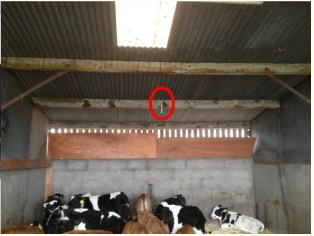Bovine respiratory disease impairs health and welfare and can have major economic consequences. In cattle respiratory disease are a significant reason for mortality, especially in calves. An early detection in case of these multifactorial disease means an earlier treatment and thus a higher and earlier chance of recovery.
One clinical sign for respiratory disease is coughing. The aim of the study cited here was to use an automated detection of cough sounds as an early warning system for respiratory disease in calves.
Sound analysis is already used for stress monitoring in pigs and monitoring of thermal comfort in chicks. Furthermore, it has been proven that sound analysis is able to detect coughing in pigs and to distinguish between cough sounds in calves and mechanical noise.
Microphones were used to record sounds in three groups of calves, a human labeller than detected some of the cough sounds in the recording, an algorithm was developed to detect more cough sounds automatically. The detected coughing events were compared to the results of visual scoring for respiratory disease, blood analysis and number and time of treated calves. It was found that sound analysis detected cough sounds to the same time or even before calves were treated for respiratory disease. Thus, sound analysis can assist in the recognition of respiratory disease in calves - in combination with visual animal inspection.
 The pircture shows the microphone hanging above the animals. The microphone has been encircled in red for spotting easier in the figure. (Vandermeulen, J. et al. 2016)
The pircture shows the microphone hanging above the animals. The microphone has been encircled in red for spotting easier in the figure. (Vandermeulen, J. et al. 2016)
The cough monitor can be used as an early warning system for respiratory diseases in calves in order to be able to mitigate their course and consequences through earlier treatment. The greatest success was that coughing sounds are actually recognized and their accumulation can be linked to the occurrence of respiratory diseases. This is an important point, because respiratory diseases are a major reason for impaired health and welfare as so as for mortality during the rearing phase in beef suckler farms.
This system is still a research project, but the automatic recording and algorithm-based filtering of sounds already works in other areas of animal husbandry, so there is little in the way of the system's possible introduction into practice.
Literature:
- Vandermeulen, J. et al. (2016): Early recognition of bovine respiratory disease in calves using automated continuous monitoring of cough sounds. Computers and Electronics in Agriculture 129 (2016) 15-26 https://www.ncbi.nlm.nih.gov/pmc/articles/PMC7114224/
This innovation has an impact on:
- 1. Socio-economic resilience : The innovation will increase the cost of calf-rearing. However, early detection of respiratory disease can save money by reduced mortality, lower treatment costs and increased weight gain of healthy animals.
- Animal health and welfare: Early detection of respiratory disease will lower the costs for vet and treatment, the animal welfare and stock health will increase and the fatality of respiratory diseases will be reduced.
- Production efficiency and meat quality: An early detection of disease means a shorter duration and thus a lower decrease in weight gain